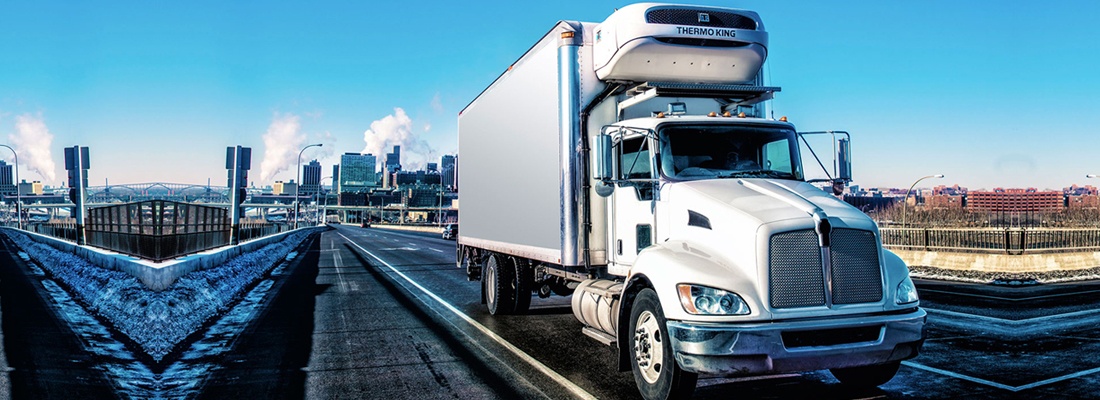Cold logistics guarantees the storage, transport, and distribution of specific products, such as vaccines and other medication, at the proper temperature to ensure integrity and quality.
Traditional supply chain logistics aim to reduce all tasks to one; by adding a cold chain we complicate its management.
Because of the temperature-sensitive nature of the products we transport, a cold chain must remain throughout the supply chain, from the moment the issuer ships the order until it arrives at the destination set by the end client or final user.
Due to their complexity, cold chains demand greater investments in infrastructure, technology, and specialization. This implies having climatized trucks, warehouses, and containers with back-up units to ensure the continuous supply of power required for refrigeration and with temperature control systems that report any variations that may place cargo at risk in real time.
Cod chains also demand trained drivers and warehouse staff to keep alert and provide immediate solutions in case of variations in temperature, and with enough knowledge of programs and procedures to process the documentation of cargoes in a coordinated and timely manner as they go through warehouses or customs.
The importance of cold logistics
Cold chains are essential for transporting perishable goods; they aim to extend the products’ lives and maintain their properties. However, it is even more important in the handling of pharmaceutical products highly sensitive to heat and cold, which effectiveness may be compromised by any sudden change in temperature.
The structure of a cold chain may take any of these two forms:
- Active Cold Chain: uses compression or absorption refrigerators or freezers to produce cold.
- Passive Cold Chain: includes shipping systems or containers to conserve temperature.
Depending on their type, cold chains are made up by these elements:
- Refrigerated warehouses located in manufacturing zones
- Refrigerated transport vehicles
- Refrigerated all-purpose warehouses
- Refrigerated commercial warehouses
- Refrigerated consumer goods warehouses
- Urban refrigerated vehicles
- Private and public refrigerated chambers and units (for retailers and wholesalers)
When installing these cooling units, we must consider some issues of goods handling that may affect the temperature of products and the energy used to reach a constant temperature:
- Cool the warehouse or vehicle for 90 minutes prior to loading to eliminate any residual heat.
- Make sure the cold air circulates freely around the complete cargo, remove any obstacles to avoid improper or deficient air circulation.
- Use plastic wrapping on pallets with fresh products; otherwise, air will not get to the cargo.
- Do not place products in front of the evaporator’s outlet to avoid blocking the flow of cold air.
- Make sure there is no paper waste or wrapping on the floor.
- Do not block the evaporator’s inlets (return air).
- Turn off the unit while the cold room doors are open.
- Do not obstruct the floor, obstacles produce short cycles.
- Avoid opening the refrigerator doors for long periods.
- Separate the perishable cargo from dry boxes / pallets using a partition.
Besides what it entails to handle products such as vaccines and other medications along the processes of cold logistics, we also need to provide continuous and preventive maintenance to the cooling units to prevent malfunctions. We also need back-up systems to ensure the cold chain remains operational.
Logistics companies providing this service offer manufacturers of pharmaceutical and perishable goods a complete integration to their business model so they can support them in reaching their goals with the lowest possible cost and the best possible efficiency.
To do this, we also need to implement the most advanced refrigeration and traceability technologies and train staff properly to ensure good service and to boost the productivity of clients.
Cold chain specialization in Latin America
The Global Cold Chain Alliance (GCCA) fosters the professionalization of logistics companies from South America that are adding cold chains to their services.
GCCA offers members in 72 countries technical support and advisory services to improve their practices by exchanging knowledge and innovation through four organizations:
- The International Association of Refrigerated Warehouses (IARW) promotes and supports excellence throughout the industry of temperature-controlled warehouses for logistics.
- The World Food Logistics Organization (WFLO) oversees the proper handling and storage of perishable goods and develops systems to improve safety, efficiency, and reliable manipulation practices around the globe.
- The International Refrigerated Transportation Association (IRTA) supports the needs and interests of companies in the transportation industry for frozen or refrigerated products. IRTA promotes good exchange and commercial relations among transport companies, their suppliers, and clients.
- The International Association for Cold Storage Construction (IACSC) supports the needs and interests of companies that build cold storage spaces, promotes innovation and operational standards in the industry of refrigerated warehousing construction, sponsors training programs, analyzes the industry’s challenges, and promotes the interests of the industry in each country’s legislation and policies.
Successful implementation in Colombia
Despite the efforts of all these institutions, Latin America still needs to improve the cold chain process; although some implementations for specialized products are already materializing with successful results.
In Colombia, Solistica has one of the largest cold rooms in South America dedicated to the refrigeration of pharmaceutical products.
It makes use of the most advanced technologies to ensure the preservation of medications and vaccines according to the temperatures specified by manufacturers, lowering waste and guaranteeing the delivery of products to patients in the finest conditions.
With a BPM (Best Practices in Manufacturing) certification, Open Market continuously improves the quality of its processes and avoids losses for its pharmaceutical clients.
Thanks to its Open Freeze warehouse, Open Market’s (now Solistica) processes of cold logistics ensure an effective integration of logistics in the product cycle, encompassing storage, isolation, conditioning, product transportation, and reverse logistics.
Cold chain challenges and trends
The trends of cold logistics are characterized by the challenges faced by logistics in general, among which we list:
- The globalization of markets.
- The decrease of costs throughout the cold chain.
- The strategic integration with the remaining tasks in the supply chain.
- The best use of capacities and resources.
Because of this reality, logistics suppliers offering cold chain services must develop strategies that let them keep their leadership in the industry:
- Keep in mind the restrictions set by the strictest health regulations in some countries so you can implement measures and refrigeration controls that guarantee the integrity and quality of products, especially pharmaceutical ones, along the entire logistics activities.
- Set up refrigerated warehouses along the supply chain to keep the temperature of the cargo within the recommended range.
- Use temperature sensors in transport vehicles to detect, in time, any variations as they travel along different weather conditions.
- Improve the traceability of products to properly document their origin, transportation process, and destination so we can make the collection of specific lots more reliable and faster, if needed.
- Implement a business approach that aims for an integration with the manufacturers’ strategic goals, lowering costs and improving the satisfaction of end clients.
- Add supplementary services to make the cold chain more efficient, give more visibility to products during shipment, and ensure just-in-time deliveries and avoid inventory issues.
- Adopt multimodal transportation to serve increasingly distant and disperse markets; making the best use of improvements to the containers’ temperature control systems.
- Use new coolants and efficient fuels to address the environmental and sustainability concerns of clients and the community at large.
- Improve packaging to prolong the durability under refrigeration and ensure the good condition of products when they reach their destination.
- Invest strongly on technological solutions to monitor cargo and temperature conditions along the supply chain, optimize the use of resources, and expedite the paperwork.
A continuous improvement effort
Having refrigerated products reach final consumers under the best safety conditions and integrity is a task tested by many variables that which requires the continuous effort and investment of the logistics supplier.
Every day more countries, starting with the European Union, adopt regulations that demand to know precisely the origin and transportation conditions of pharmaceutical and perishable products.
Paying attention to these regulations and to the changing demands of consumers who increasingly demand fresh and preservative-free products exerts pressure on manufacturers and logistics companies.
Logistics suppliers must help clients meet the regulations of each country efficiently in terms of cost and, at the same time, they must deliver products on time and under the best conditions to consumers in order to guarantee the competitiveness of the manufacturers.
Ticking all these boxes demands setting up efficient processes, improve productivity, and guarantee safety; therefore, technology has become the best ally of logistics companies.
From temperature sensors, localization and control systems, automation of warehouses, and blockchain technology to broadcast information, technological advances have the purpose to ensure the quality of goods, guarantee timely delivery, lower inventory and operational costs, improve the traceability of lots, and ensure the integrity of the documentation shared with the different parties involved in the cold chain.





